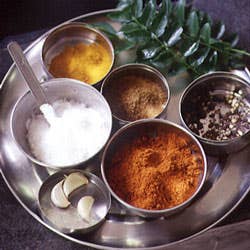
The Kerala Kitchen Pantry
The staple ingredients mentioned in Feast of Harmony are listed here according to how they're sold in the United States. Most often the English term is used, but sometimes Hindi or Malayalam, Kerala's indigenous language, is more common.
COCONUT OIL:
Extracted from dried coconut, this oil is solid when cool; once melted, it's used for sauteeing or drizzled over cooked curries to add flavor. It spoils quickly, so keep it in the fridge.
CURRY LEAVES:
No relation to commercial curry powder, these bright green leaves, when fried, release a flavor that is a cross between those of grapefruit and green peppers. Always use fresh leaves, as the dried have no taste, and set the leaves aside as you eat—they're a bit leathery.
DHAL (legume):
A term that encompasses all dried raw legumes—peas, beans, and lentils—as well as any kind of Indian cooked-legume dish. Certain dhals may also be fried and mixed into curries or rice dishes to give them crunch.
WHOLE DRIED HOT RED CHILES:
Labeled "cayenne" or sometimes just "red chile". Any variety 1 to 2 inches long may be used.
GHEE (Indian clarified butter):
This nutty-tasting butter has a high smoke point, keeps for months with no refrigeration, and is used in both sweet and savory dishes. (See Ghee in a Nutshell.)
MUSTARD SEEDS:
Indians use the small brown variety, but yellow may be substituted. When heated in oil, they pop, releasing a toasty flavor.
RICE FLOUR:
This silky flour, milled from rice, is used to make pancakes and breads.
SALT:
Salt is essential for bringing out the full flavor of Indian food. Moreover, it tempers the heat of chiles and softens the bite of tamarind or other sour ingredients.
SEMIYA (fine wheat noodles):
Also called "vermicelli" in India, they have the diameter of angel hair pasta and are used in desserts and stir-fries.
TAMARIND PULP:
The sticky brown pulp of the tamarind pod that is sold in blocks is more flavorful than the smooth concentrate sold in jars.
Keep Reading
Continue to Next Story










